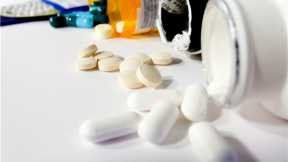This is an automatically translated article.
Glyclamic drug belongs to the group of hormonal and hormonal drugs, which is indicated for the treatment of type 2 diabetes when the patient's diet is not effective. So how is Glyclamic used? The following article will provide necessary information about the effects and precautions when using this drug.
1. What is Glyclamic?
Glyclamic contains the ingredient Glibenclamide 5mg and the excipients are just enough provided by the manufacturer. The drug is prepared in the form of tablets, packed in a box of 5 blisters, each blister has 20 tablets.
Pharmacodynamics:
Glibenclamide is the active ingredient contained in antidiabetic drugs of the Sulfonylurea group.
Pharmacokinetics:
Absorption: Glibenclamide is well absorbed from the gastrointestinal tract. However, food and increased blood glucose may reduce the absorption of the drug. For early optimal plasma concentrations, the drug should be administered 30 minutes before a meal. This also ensures good insulin release during the meal. Distribution: Glibenclamide is highly (90-99%) bound to plasma proteins, especially albumin. The volume of distribution of Glibenclamide is approximately 0.2 liters/kg. The duration of action of the drug does not affect the plasma half-life. Metabolism: Glibenclamide is completely metabolised in the liver, mainly by hydrogenation. The metabolites also have a moderate hypoglycemic effect, but in subjects with normal renal function this effect is not important. Elimination: The drug is eliminated mainly by the kidneys.
2. Uses of Glyclamic
Glyclamic drug is indicated for treatment in the following cases:
Patients with non-insulin dependent type 2 diabetes who have been treated with diet without achieving the desired effect. Besides the therapeutic effects, Glyclamic drug is contraindicated in the following cases:
Allergy to the active ingredient Glibenclamide or other excipients in the composition of the drug. Insulin-dependent type 1 diabetes (diabetes seen in young adults). Disturbances of glucose metabolism with blood metabolic acidosis. Elevated blood sugar with or without coma (diabetic coma or pre-coma). After pancreatectomy. Patients with severe liver and kidney dysfunction. Pregnant and lactating women.
3. Dosage and how to use Glyclamic
Glyclamic drug is prepared in the form of tablets, used orally. The drug should be swallowed whole, without chewing, breaking or crushing the tablet before taking it. The drug should be taken in the early morning 30 minutes before breakfast.
The following is the recommended dose of Glyclamic:
Usual starting dose: 2.5 - 5 mg/day. Usual maintenance dose: 5 to 10 mg/day. The maximum dose is 15mg/day. Doses greater than 10mg/day should be divided into 2 oral doses. In case of need to adjust the dose, every 1-2 weeks increase by 2.5mg / time, until the required level of blood glucose index is reached. For the elderly with malnutrition, the dose should be reduced, because the effect of Glyclamic is relatively long-lasting, so it should be used with caution in the elderly. For patients with liver and kidney damage, a starting dose of 1.25 mg/day should be used, considering the glycemic index to adjust the dose appropriately for this subject. This dose is for reference only, depending on the medical condition for the doctor to determine the appropriate dose for each patient.
4. Glyclamic side effects
Doctors always consider between the benefits that Glyclamic drugs bring to the patient and the possible risk of side effects to prescribe the appropriate medication. Patients need to follow the doctor's instructions to avoid unwanted effects. Glyclamic side effects are usually mild and transient. Some side effects may occur when taking the drug as follows:
Digestive disorders such as nausea, vomiting, diarrhea, abdominal distension, belching. Hypersensitivity reactions in the skin such as rash, pruritus, urticaria. Patients should monitor for suspected drug-related side effects, notify their doctor when their condition worsens, and seek immediate medical attention.
5. Glyclamic drug interactions
Tell your doctor about all the medicines you are using such as prescription drugs, over-the-counter medicines, dietary supplements, herbs... to avoid interactions that occur when used in combination with Glyclamic during treatment.
6. Some notes when using Glyclamic drug
Here are some notes when taking Glyclamic medicine to help achieve the effectiveness of the drug as well as reduce the risk of side effects:
After taking the drug, the patient may experience hypoglycemia, so it is recommended Prepare food for the sick. The risk of hypoglycaemia can also occur when people drink too much, excessively diet, drink alcohol while taking drugs or exercise too hard. Above is information about uses, dosage and precautions when using Glyclamic. To ensure safety for your health and maximize the effectiveness of your treatment, you need to take Glyclamic medicine exactly as directed by your doctor.
Follow Vinmec International General Hospital website to get more health, nutrition and beauty information to protect the health of yourself and your loved ones in your family.
Please dial HOTLINE for more information or register for an appointment HERE. Download MyVinmec app to make appointments faster and to manage your bookings easily.













